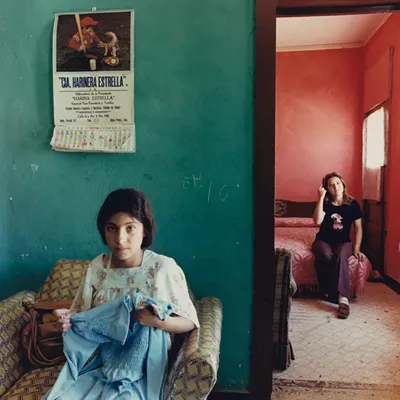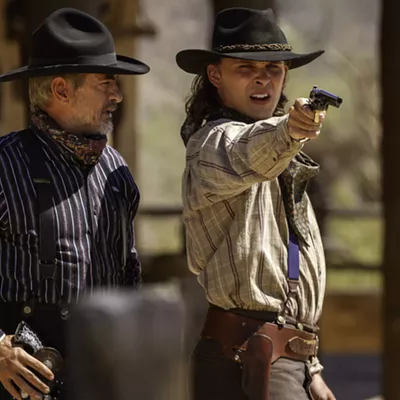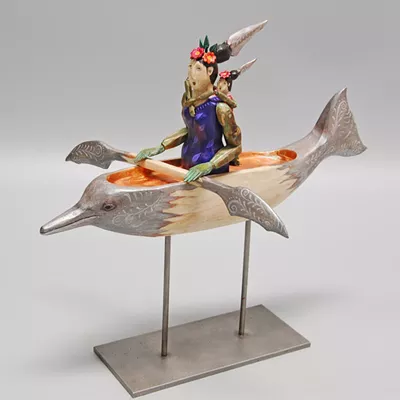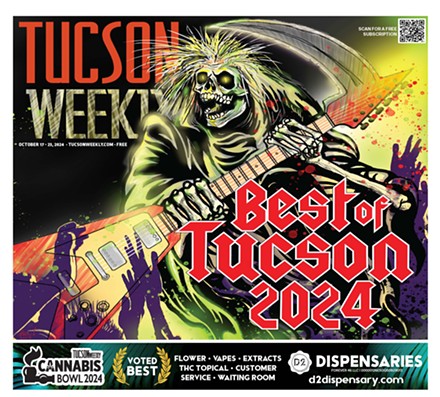The spirit of Frida Kahlo hovers—sort of—over an unusual outdoor exhibition at the Tucson Botanical Gardens.
Frida Kahlo: Art, Garden, Life examines the influence of indigenous Mexican plants on Kahlo's art. Cacti, agave, trees and bushes that she might have been familiar with are tagged throughout the extensive gardens. But the centerpiece is an installation that evokes her famous Caza Azul, the blue house where she was born and where she died.
Kahlo's sprawling real-life Mexico City house and patio are suggested by a several walls, painted an intense Frida Kahlo blue and Diego Rivera red, and set up temporarily as an open-air enclosure in the gardens. Inside is a bright yellow-and-red makeshift Aztec pyramid, a replica of a structure that Rivera, Kahlo's off-and-on husband, built to house his collection of Pre-Columbian artifacts. The curators tell us that Kahlo (1907-1954), who famously painted Mexican flowers and vines into her self-portraits, used the house and its patio garden as both art inspiration and laboratory.
Posters and reproduction photos with info on the house and Kahlo's life abound, but apart from a suite of formal portraits of Kahlo, taken by photographer Nickolas Muray in the 1930s (displayed safely inside Porter Hall), the only original artwork here is by a contemporary Mexican artist, not by Kahlo herself.
Fortunately, Humberto Spíndola's 2009 piece delivers an important insight into Khalo's art. His sculpture, "The Two Fridas," is inspired by Kahlo's famed 1939 painting, pictured here in a small reproduction. In the original, her first large-scale work, Kahlo painted herself twice, conjuring her mixed heritage as the daughter of a German-born father and a Mestiza Mexican mother of Indian and Spanish heritage. The seated Frida on the left is dressed in a white Victorian lady's dress. The Frida on the right wears indigenous traje, the traditional blouse and skirt of a Mexican Indian woman.
Spíndola dispenses with the European-based oils that Kahlo used. Instead, in a move that Kahlo would no doubt have approved, Spíndola leaps backward in time to an art material prized by the ancient Aztecs. Giving a nod to amate, the paper they crafted out of bark, Spíndola sculpts the two dresses entirely out of paper.
He crinkles shiny white sheets into the folds and poufs of the Victorian dress, and rich blue and green papers into the loose and comfortable garb of the Indian. Importantly, he twists red paper into two bleeding hearts, one for each of the suffering women.
But in using an Aztec material, he embraces indigenismo, honoring the cultural practices of Mexico's native peoples. Kahlo did likewise. Her artwork bled for all women, but it was the Mexican identity, not the European, that she chose in her life and her art.
Over the years, Kahlo's work has been so heavily commercialized and kitsch-ified—her iconic uni-brow appears on everything from aprons to sticky notes—that it's hard to remember her radical artistic intentions. She was not just painting pretty pictures of flowers and vines and animals. She was "painting the revolution," as an aptly named exhibition of Mexican Modernism now at the Philadelphia Museum of Art demonstrates.
In the decades after the Mexican Revolution of 1910-1920, a coterie of impassioned Mexico City artists invented Mexicanidad, an exhilarating new modernism that lionized indigenous Mexican culture and motifs. Rivera, for one, had studied art in Europe and imbibed its modernism—he painted cubist works for a while—but he transformed the lessons of the Old World avant-garde into a new Mexican modernism. His public murals, drenched in Aztec iconography and shaped by Communist ideology, celebrated the farmworker, the factory worker and the heroic labors of all the downtrodden.
Kahlo, 20 years his junior, shared his Communist and artistic beliefs, but she pioneered her own dazzling form of Mexican-feminist-indigenous modernism. Often confined to bed by pain and disability, Kahlo made wrenching self-portraits that convey her own suffering and despair. But she also addressed the travails of women in general, in paintings of blood, bones and dead babies.
If Rivera and the other muralists addressed the big ideas of labor and property, Kahlo's work addressed the equally big ideas of fertility, childbirth and sexuality, making the personal political, to use a now-tired saw. And like Rivera and the other great muralists of the period, she rejected European aesthetics and embraced the symbols of Mexican indigenismo.
Partly imported from the New York Botanical Gardens, the Tucson Botanical Gardens' exhibition doesn't do too much with this radical history. It's at its best explaining how Kahlo's passion for indigenous imagery and folk art led to the cornucopia of flowers, plants, vines and animals in her paintings.
For instance, a label on the Mexican honeysuckle planted in the garden links it to Kahlo's 1940 work "Self-Portrait with Thorn Necklace and Hummingbird." In the painting, a dead hummingbird hangs from a honeysuckle vine wrapped around the artist's neck. According to indigenous belief, the label says, a dead hummingbird could "entice a lost loved one to return."
Plenty of other labeled plants, though, have no text drawing an explicit connection to Kahlo's art. It's pleasant to stroll among the Mexican plants, but it would have been useful if the curators had put more emphasis on their relationship with the paintings.
Within the phantom Casa Azul, there's quite a bit of information about Kahlo and Rivera's remaking of both house and garden. The transitions mirror their transformations as artists. When Kahlo was born in the house, it had French neoclassical ornamentation on the exterior. But just as she gave up her schoolgirl jumpers and began wearing loose Indian dresses and skirts, she eventually stripped the house of its European decorative elements and painted its exterior in bold bands of Aztec blue and red. The pair installed a fountain (reproduced in the show) whose floor is a tile mosaic of the snakes and frogs, a design not only drawn from indigenous lore but from Kahlo's pet nickname for Rivera—Sapo-rama, or Toad Frog.
And Kahlo dispensed with the imported roses and ivy her parents had cherished, and replaced them with the plants of her native Mexico, its cacti and agave, its yuccas and flores de muertos.










